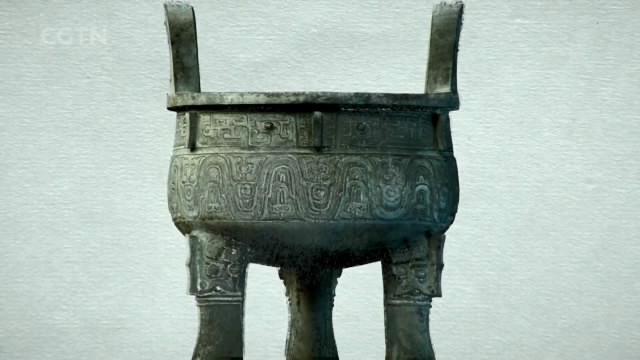
14:59, 17-May-2018
'If Treasures Could Talk': 'Ke ding' tells story of life in Zhou dynasty
05:14

We continue our series "If Treasures Could Talk", showcasing some of China's most valuable ancient treasures. Today, we take a look at the Great Ke ding. The 290 characters inscribed on it not only tell the story of ancient Zhou Dynasty but also show the skills of Zhou craftsman.
At Shanghai Museum, 3D photography is being used to capture every aspect of this unique artefact. The images will be used to create a high-definition 3D model. This will reveal details that until now, have been very difficult, even impossible, to discern.
The great Ke ding is Shanghai Museum's most precious exhibit. It's 93.1 centimetres tall, has a diameter of 75.6 centimetres, and weighs 201.5 kilograms. However, it's not its size that makes it unique, but the words inscribed on its interior. They offer us a glimpse into Zhou dynasty life, almost three thousand years ago.
The text, dictated by a nobleman called Ke, starts: "My grandfather was an honourable man and a skilled writer. He was mild and considerate, modest and calm, pure and wise."
Thanks to these qualities, the King of Zhou had raised the family to a high official position.
Under Western Zhou, official positions were hereditary. Out of respect, descendants would inscribe bronze objects with eulogies, praising their ancestors.
Dings were the most important ritual vessels at the time. Noble families would have their dings, as well as bells, inscribed with records of important events. Today, these artefacts serve as books printed on bronze – a source of information on history.
The 290 characters inscribed on the Ke ding shed light on the ancient Zhou Dynasty. "The king said: 'I bestow upon you red garments, untilled fields, tilled fields, and slaves to work them'."
These words reveal something about the system of hierarchy, the rituals, and the disposition of land under the Western Zhou Dynasty. But the ding's significance isn't only as a source of historical information. The calligraphy, executed by skilled Zhou craftsmen, is considered a masterpiece. The 290 characters are remarkably clear and well-ordered.
The inscription ends: "May the Son of Heaven's bounty and my ancestors' grace bless my descendants for ten thousand years."
However, nothing lasts forever. Soon after the ding was cast, Western Zhou was swallowed up in the chaos and warfare of the Spring and Autumn Period. It seems unlikely that the Ke family continued to enjoy any further good fortune.
After China was unified under the Qin Dynasty in the 3rd century BC, a new style of calligraphy, small seal script, replaced that appearing on the ding. Then, with the advent of the Han Dynasty in 206 BC, bronze began to go out of use.
The ding was discovered in a Shaanxi cellar in 1980. From it, we have learned that two thousand years ago, a man named Ke was awarded office, land, clothing, and even slaves by the King of Zhou as a reward for his grandfather's meritorious service. In an inscription on the ding, Ke expressed his gratitude to his ancestor, as well as the wish that his descendants would share his glory forever.

SITEMAP
Copyright © 2018 CGTN. Beijing ICP prepared NO.16065310-3
Copyright © 2018 CGTN. Beijing ICP prepared NO.16065310-3